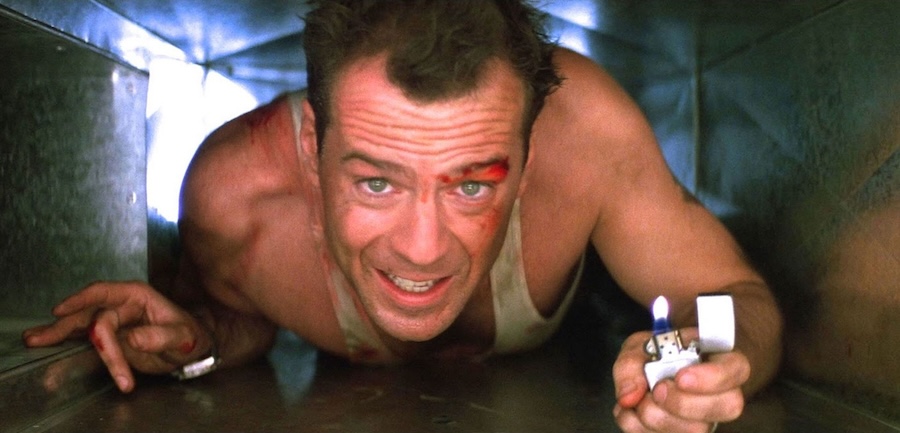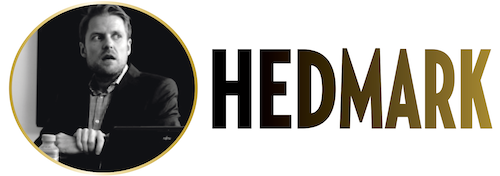
40 STORIES OF SHEER ADVENTURE!

Where would Bruce Willis be without this film? In 1988, he had spent several years charming viewers as a private eye on the hit series Moonlighting. He had won a Golden Globe and an Emmy for his performance, but didn’t really seem destined to become a big-time movie star. But then Die Hard came along and delighted audiences worldwide. Surely, Willis’s smirk had something to do with it.
Arriving for a Christmas party
New York detective John McClane (Willis) arrives in Los Angeles where his wife Holly (Bonnie Bedelia) has been working for some time. She’s employed with a Japanese corporation, Nakatomi, whose American headquarters are located in a highrise. A Christmas party is about to take place, but John and Holly are not exactly in a festive mood; her moving to L.A. is a point of contention between them. Their bickering is interrupted by a heavily armed gang of terrorists who take control of the highrise by executing the sole security guard and cutting the phone lines. They are led by an elegant, smooth and icy German called Hans Gruber (Alan Rickman), who’s actually after a vault containing bonds worth over $600 million.
McClane was in the men’s room when Gruber’s gang struck. Now he must use his mind and every resource the highrise has to come up with a way to thwart the criminals’ plan.
Taking advantage of every corner of the place
McClane sure is bad news, bending rules, taking on bad guys by using their own methods against them. That kind of character combined with a sense of humor and a lot of blood is familiar from the previous year’s Lethal Weapon (1987), but director John McTiernan’s taut, explosive film also borrowed an older, highly effective formula where the story is strictly confined to one location. Howard Hawks, for instance, used it successfully in Rio Bravo (1959). The benefit of the formula is that it’s easier to generate and maintain tension by sealing the characters off somewhere and making them fight for their lives.
There’s a barrage of exciting shoot outs, explosions and bloody fights, all of it expertly staged.
McTiernan and his crew take advantage of each corner of the place, including the elevator shaft in one memorably intense sequence. There’s a barrage of exciting shoot outs, explosions and bloody fights, all of it expertly staged. But refreshingly enough the film also makes us laugh; McClane may be under crushing pressure, but still has time to throw a few funny wisecracks at us. There’s also an obnoxious reporter (William Atherton) covering the event… and Reginald VelJohnson is great as the friendly, rotund cop who gets the shock of his life when he first arrives at the scene.
Willis works hard as our hero whose white tank top gets dirtier with each brawl he runs into; McClane may pull a few superhuman stunts, but still comes across as an everyman. Rickman is brilliant as the snarling, intelligent villain with an accent, the kind of role that always seems to require a distinguished British actor.
Watching all that action in a highrise reminds me of The Towering Inferno (1974) and the 1970s trend of disaster movies. The drama of this film certainly is catastrophic in nature, and Die Hard would itself inspire many inferior films. Nothing is truly original, I guess. Then again, how many action movies can lay claim to being a Christmas classic?
Die Hard 1988-U.S. 131 min. Color. Widescreen. Directed by John McTiernan. Screenplay: Jeb Stuart, Steven E. de Souza. Novel: Roderick Thorp (”Nothing Lasts Forever”). Cinematography: Jan de Bont. Visual Effects: Richard Edlund. Cast: Bruce Willis (John McClane), Alan Rickman (Hans Gruber), Bonnie Bedelia (Holly McClane), Alexander Godunov, Reginald VelJohnson, Paul Gleason… Robert Davi.
Trivia: Richard Gere, Burt Reynolds, Harrison Ford and Arnold Schwarzenegger were considered for the part of McClane; due to contractual reasons, Frank Sinatra was offered it. Followed by four sequels, starting with Die Hard 2 (1990).
Last word: “I think that a big part of what initially went into the character of John McClane back in 1986, ’87, was the fact that I had only done a couple of films and a big part of my character was informed by my South Jersey roots, working-class background, South Jersey roots, a very healthy disregard and lack of respect for authority, and a pretty dark sense of humor. […] I never consciously thought that I wanted to play it as an everyman, but it just kind of turned out like that.” (Willis, IGN)
